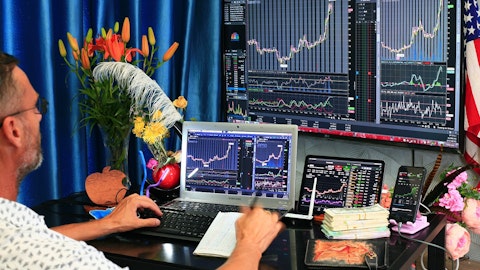2. NVIDIA Corp. (NASDAQ:NVDA)
Average Volume (3-Month): 284.54 million
Number of Hedge Fund Holders: 223
NVIDIA Corp. (NASDAQ:NVDA) is a computing infrastructure company. Its Compute & Networking segment comprises Data Center computing platforms and end-to-end networking platforms. The Graphics segment offers GPUs, game streaming services, and related infrastructure, as well as solutions for gaming platforms.
On May 12, UBS lowered the price target on NVIDIA to $175 from $180 while keeping a Buy rating. The firm expects FQ1 2026 revenue to be ahead of the $43 billion guidance, despite the recent H20 ban. This ban addressed US export restrictions, so NVIDIA is preparing a downgraded version of its H20 chip for China. This could help it stay competitive in a key market. China contributed $17 billion in revenue to NVIDIA, which was 13% of the company’s total sales in FY2025.
Due to heightened demand from major Chinese tech firms such as Alibaba and ByteDance, Reuters reported that NVIDIA received orders worth $18 billion for the H20 chip since January 2025. The company plans to manufacture up to $500 billion of AI supercomputers within the US over the next 4 years. UBS expects growth to reaccelerate in H2 as the company is potentially allowed to resume shipments of data center GPUs to China.
Guinness Global Innovators is highly bullish on NVIDIA Corp. (NASDAQ:NVDA) due to its dominant AI chip market position. It stated the following in its Q4 2024 investor letter:
“For a second year running, NVIDIA Corporation (NASDAQ:NVDA) was the Fund’s top performing stock, delivering a stellar return of +177.7% over the year. Since the beginning of last year, Nvidia’s ‘Hopper’ GPUs have been at the centre of exploding demand for chips powerful and efficient enough to facilitate the energy intensive requirements of AI processes within datacentres. Initially possessing over 95% of market share in these types of chips, Nvidia have been quick to entrench their position as the technological leader in the space, launching the successor to the current ‘Hopper’ GPU in March, Blackwell, inhibiting the likes of AMD and Intel making meaningful inroads in taking share of the fast-growing market. Compared to the previous iteration (Hopper) which is continuing to fuel Nvidia’s extreme revenue growth, the Blackwell chip is twice as powerful for training AI models and has 5 times the capability when it comes to “inference” (the speed at which AI models respond to queries). Throughout the year, Nvidia’s financial performance has remained resilient. Quarterly revenues hit $35.1 billion in their most recent quarter, beating consensus expectations by 6% and representing a +94% year-over-year increase. Additionally, Nvidia’s data centre segment, driven by the Hopper (H100) chip, grew fivefold over the past year, underscoring the sustained demand for advanced AI infrastructure. The H100 chip, priced at around $40,000, continues to see significant adoption due to its ability to enhance AI model training efficiency while lowering overall costs. This growth is expected to continue as companies invest in upgrading existing data centres and building new ones, with Nvidia well-positioned to capture a significant share of the estimated $2 trillion market opportunity over the next five years. There have been some concerns over Blackwell production delays causing share price volatility however, Nvidia has recovered swiftly, driven by positive earnings results through the year and assurances from management regarding future supply. Additionally, the release of the H200 chip promises to extend Nvidia’s technological leadership, ensuring continued momentum into 2025. While Nvidia’s valuation remains a topic of debate, the stock is not at a significant premium to history, and it still appears reasonable given its dominant market position, innovative prowess, and exposure to long-term secular growth trends in AI, cloud computing, and data infrastructure. As a result, Nvidia remains well-positioned to deliver sustained outperformance over the long term, making it a cornerstone of growth-oriented portfolios.”





